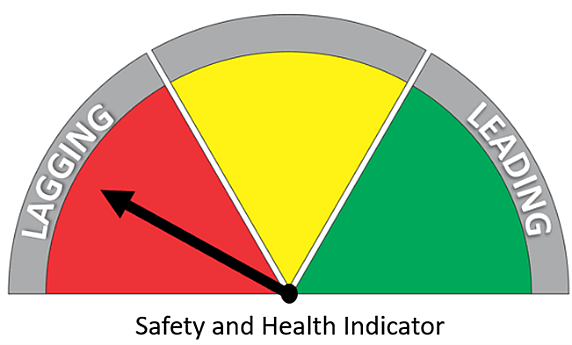When it comes to workplace safety and health indicators, do you use ones that lag, lead, or both? When developing and managing a good safety and health program, leading indicators should be used in combination with promoting employee involvement, engagement, and empowerment. Lagging indicators may be used when measuring the program’s effectiveness.
Leading Indicators
Leading indicators are those that look ahead, that try to prevent workplace injuries, accidents, and illnesses. They include proactive and predictive measures such as holding safety discussions and encouraging employees to express safety concerns, make suggestions for improvements, and provide other environmental, health, and safety (EH&S) related feedback. Results from on-the-job task observations, health and safety inspections, and employee safety perception surveys may also be used to indicate potential safety and health issues. Examples of leading indicators also can include the items listed below:
- Promoting an integral safety culture, with both leadership and employee buy-in
- Creating a safety committee
- Performing risk assessments, job safety analyses (JSAs), and job hazard analyses (JHAs)
- Requiring the reporting of unsafe acts, unsafe conditions, and near misses
- Providing mandatory EH&S training for all employees
- Tracking data, especially for routine inventories, inspections, and maintenance of employee protective and emergency response equipment such as:
- Fire extinguisher inspection
- Spill kit inventory
- Safety shower and eye wash testing
- Fume hood, biosafety cabinet, and other ventilation calibration, repair, and preventive maintenance
Lagging Indicators
Lagging indicators are those that look back instead of forward, providing information that occurred in the past, such as accident, illness, and injury reporting, OSHA recordable incident rates (OSHA 300 Log), disciplinary or corrective actions, and other reports that indicate non-compliance with safety and health regulations and company policy. Lagging indicators often reveal missed opportunities to control hazards and prevent exposures, as well as safety and health program, plan, and policy deficiencies. Some additional examples of lagging indicators are:
- Expenses (e.g., Workers’ compensation claims, liability and/or litigation costs),
- Property damage, and
- Incident Rates (e.g., Total Case Rate (TCR), OSHA Days Away, Restricted, and Transfer (DART) Rates)
Measuring Program Effectiveness
Whichever indicators are used, how effective your safety and health program is should be measured on a regular basis. When developing programs and plans, the expected goal(s) should be considered. Have the number of recordable injuries and illnesses, or workers’ compensation claims decreased? Are employees reporting more unsafe acts, conditions, or near misses? If so, by what percent? If goals were not attained, investigations should be conducted along with program modifications. After each review and update of policies, plans, and procedures, additional goals or better results can then be adopted.
While not considered leading or lagging indicators, nor are they typically environment, health, or safety focused, business impact measures such as service continuity, reputational risk, and financial health can also help to provide some program efficacy insight. Additional business impact measures may include, but are not limited to:
- Low[er] employee morale,
- High[er] turnover rates, and
- Reduced productivity
Be a Leader!
When implementing or updating your comprehensive EH&S program and developing a robust safety culture, remember to be a leader! OSHA’s Recommended Practices for Safety and Health Programs publication, Using Leading Indicators to Improve Safety and Health Outcomes, has additional information to assist you in that process.
Safety Partners can create and assist with managing a leading Safety and Health Program at your workplace – Contact us for more information!
This blog was written by Kim Folger, Safety Partners’ Training and Development Manager.


